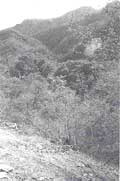The Eklingapura experience
 NESTLED in the hills of the Aravallis about 12 km from Udaipur, Eklingapura shines as one of the first successful instances of participatory forest management.
NESTLED in the hills of the Aravallis about 12 km from Udaipur, Eklingapura shines as one of the first successful instances of participatory forest management.
Eklingapura has a population of 1,400 over 200 households of various castes and 1,600 livestock. The land was once covered with dense forests of Salar, Khair, Ronjh, Tendu, Aonla and other species characteristic to the Aravallis.
"Our numbers increased unbelievably and we started removing the deadwood from the forests. We then switched to green felling and finally removed the roots of the forest trees," said Ramlal Dangi, a village elder. However, forced by scarcity of fodder, "we persuaded each other to join hands with foresters of the Udaipur (south) forest division to help re-green the depleted hills", says Kishan Lal Sharma, former sarpanch of the village.
More grass The forest division initiated a programme to plant 250 ha of forest land between 1987 and 1990, emphasising on increasing the production of grass, a much needed commodity in the village. Today, every household in the village is a member of the newly constituted village forest protection and management committee.
Each participating member makes an annual contribution of 5 kg of wheat or maize to pay the wages of the community-paid plantation watchmen. Every committee member is responsible for protecting plantations from theft, illicit felling, fire and encroachment.
They also repair the rubble-wall fencing by donating collective and voluntary labour, generating 200 human days a year. "We often punish ourselves for wrong- doings and we don't allow our cattle to graze and destroy the plantation. We collect only dead and fallen twigs... and we will not allow anybody to do otherwise," asserts Lakshmi Chand Gameti, a tribal member of the committee's executive body.
Eklingapura is probably the only village where foresters are publicly honoured in a special annual meeting of the committee. As a token reward, foresters and forest guards have been receiving field dresses since 1987.
After the community took over the protection of forest lands, local tree species have regenerated dramatically from existing root stocks. Though earnings from the plantations are yet to come in, "the bumper crop of grass we have been able to harvest for the past four years has been our biggest immediate benefit", Ramlal points out.
Regenerating forests are not only providing benefits of a watershed for the community, they are also supporting local ecosystems. For instance, these areas offer excellent nesting for birds that help adjoining farms by eating insect pests.
During the harvest in October-November, every participating household is allowed to send two adults a day to cut grass from the plantations. However, only one of them is permitted to bring back a head load, the other assisting to cut the grass. An interesting pattern of resource use has emerged where the grass is harvested mostly by women, while men protect the plantations from theft, illicit grazing and cutting and keep the fence in good repair. The poorer families sell the surplus grass in Udaipur during periods of scarcity in May and June, earning up to Rs 50 a day.
The joint forest management initiative succeeded at Eklingapura mainly because foresters were able to respond to the needs of the community by creating fuelwood and fodder plantations. They were also able to convince the villagers that an equitable, mutually beneficial and sustainable partnership was possible in managing forests for the good of the people.
"It was a question of survival. We had only two alternatives -- protect or perish. We opted for the better and today, we are a fodder-surplus village," remarks Kishan Lal Sharma.
